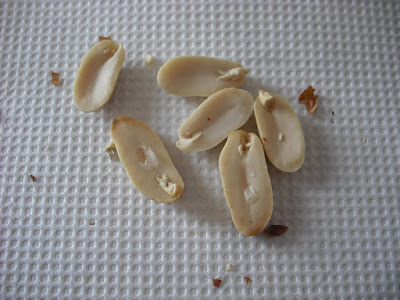For supper tonight, I made udon suki.
A bit of udon suki: In short, udon suki is yose nabe with udon noodles in it. In other nabemono, noodles or cooked rice is sometimes added after the diners have had the ingredients, but in udon suki, udon are cooked and eaten together with other ingredients.
Udon suki was invented by Satsuma Heijiro, the founder of a restaurant in Osaka, Mimiu, around 1928. Udon suki became a registered trademark of Mimiu in 1960, but in a lawsuit filed against another restaurant, Tokyo High Court decided in 1997 that the dish name udon suki had become a general noun.
うどんすきに関して少し: 簡単に言うと、うどんすきとは、うどんの入った寄せ鍋です。他の鍋物では、具を食べ終わってから、麺類やご飯を入れることがありますが、うどんすきでは、うどんを他の具と一緒に調理し、食べます。
うどんすきは、美々卯という大阪にある料理屋の創業者、薩摩平太郎が1928年頃、考案したもので、うどんすきは1960年に美々卯の登録商標になりました。しかし、他の料理屋に対して起こされた裁判で、東京高等裁判所は1997年に、うどんすきという料理名は既に一般名詞化していると判断しました。
A quick Google search revealed that prawns and other seafoods, chicken, and dashimaki tamago (rolled omelet in Kansai) are among the preferred ingredients. I decided to make udon suki my own way, however.
グーグルでちょっと検索すると、海老などの魚介類、鶏肉、出し巻き卵などがよく具材として使われることが分かりました。しかし、私は自分なりにうどんすきを作ることにしました。

Instead of dashimaki tamago, I made six kinchaku (purses), also called takara bukuro (treasure bags), with eggs in four of them and a piece of mochi in other two.
出し巻き卵の代わりに、巾着(宝袋とも)を6個作りました。4つは卵で、残りの2つは餅を入れました。

Preparations are almost done!
準備はほぼ完了!

I first put vegetables except mizuna and naga negi in the donabe. When the donabe came to a boil, I put the kinchaku. No place to add udon or chicken tsukune (ground chicken balls)!
まず土鍋に、水菜と長ネギ以外の野菜を入れました。土鍋が沸騰したら、巾着を入れました。うどんや鶏のつくねを入れる場所がない!

This is the star of today's nabe: Frozen Sanuki udon!
今日の鍋の主役: 冷凍讃岐うどんです!

Firm and tasty!
コシがあって、美味しいです!
Sorry, this is the last photo I took of the udon suki.
すみませんが、これが最後に撮ったうどんすきの写真です。

I'll add some more text later.
後で文章を足します。
Edited to add:
For the broth, combine the following:
1,400 ml water
2 tsp instant dashi
1 tsp salt
1 tbsp soy sauce
Ingredients that I used:
1/2 carrot
1/4 daikon
2 naga negi (Japanese scallion)
6 leaves Chinese cabbage
2 bunches mizuna
1 bag boiled honey mushrooms (instead of enoki or shiitake)
1 pack sardine tsumire
1 pack 2-color tsumire
For tori tsukune (chicken balls), combine:
200 g ground chicken
1/2 naga negi, finely chopped
1 knob grated ginger
1 egg
Add some katakuriko (potato starch) to adjust the softness.
When the donabe comes to a boil, start adding the tsukune, one spoonful at a time.
For six kinchaku (or takara bukuro), use the following:
3 abura age
Buy thick (expensive) ones, not cheap (thin) ones.
4 eggs
1 kiri mochi (precut, rectangular mochi), cut in half
6 toothpicks
Directions:
1. Pour hot water over abura age to remove excess oil.
2. Cut each abura age in half.
3. Open each half carefully from the cut end to make a pouch.
4. Break an egg and put it in a small container.
5. Transfer the egg to a pouch.
6. Seal the cut end with 1 toothpick.
7. Repeat steps 4-6 for 3 other pouches.
8. Cut 1 kiri mochi in half, and put each half in a pouch, and seal with 1 toothpick.
Preferably, use thick, firm udon.
Note that udon suki is still a registered trademark of Mimiu. As a sign of my respect for the inventor of this nabe, here are results of a Google image search for udon suki Mimiu in Japanese.
Images of udon suki MimiuYou may have to click 検索 near the top of the window that appears to view all the photos.
By the way, the Chinese characters for Mimiu is beauty, beauty, rabbit.
***
追記:
汁として、次のものを混ぜます:
水 1,400 ml
出汁の素 小さじ1
塩 小さじ1
しょう油 大さじ1
私が使った具:
ニンジン 1/2本
大根 1/4本
長ネギ 2本
ハクサイ 6枚
水菜 2束
茹でたナラタケ 1袋(エノキやシイタケの代わり)
イワシのつみれ 1パック
2色つみれ 1パック
鶏つくねには、次のものを合わせます:
鶏挽き肉 200 g
刻んだ長ネギ 1/2本
すったショウガ 1カケ
卵 1個
必要に応じて、柔らかさを調節するため、片栗粉を足す。
土鍋が沸騰したら、1さじづつ、つくねを入れます。
巾着(宝袋)6個には、次のものを使います:
油揚げ 3枚
薄い(安い)のではなく、厚い(高い)のを買います。
卵 4個
切り餅 1個、半分に切る
楊枝 6本
作り方:
1. 熱いお湯を油揚げにかけて、余分な油を抜きます。
2. それぞれ半分に切ります。
3. 切った端から丁寧に開いて、袋を作ります。
4. 卵を割って、小さな容器に入れます。
5. 卵を袋に移します。
6. 切った端を楊枝1本で留めます。
7. 4~6を繰り返し、他の3つも作ります。
8. 切り餅を半分に切り、それぞれを袋に入れ、楊枝で留めます。
できれば、太くて、コシのあるうどんを使ってください。
うどんすきは、今でも美々卯の登録商標です。この鍋の考案者に敬意を表して、うどんすき 美々卯のGoogleイメージ検索の結果を載せておきます。
うどんすき 美々卯全ての写真を見るには、表示されるウインドーの上部近くの「検索」をクリックする必要があるかも知れません。
ところで、美々卯という漢字は、beauty, beauty, rabbitという意味です。
Made some corrections on Jan. 8.
1月8日に若干修正。

















































